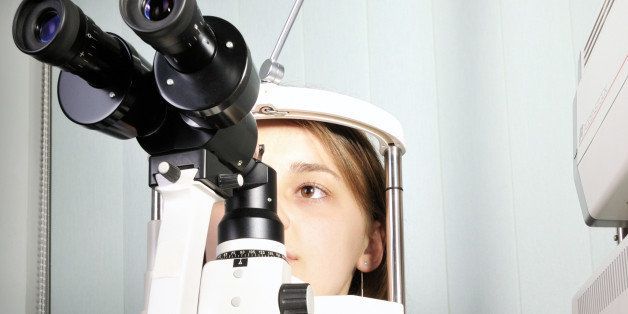
Paul A. Sidoti, MD
Deputy Chair for Clinical Affairs
Department of Ophthalmology
The Mount Sinai Health System
Why Parents Need to Know the Signs of Childhood Glaucoma
Think of someone you know who has glaucoma, a common eye disease and major cause of blindness in the United States. Chances are, it's an older adult, as glaucoma affects more than 2.2 million Americans over age 40, with the majority age 70 or older. It may come as a surprise, then, to learn that about 1 in 10,000 babies is born with glaucoma, according to the American Academy of Ophthalmology. While uncommon, childhood glaucoma is a serious medical problem, and early diagnosis and treatment offer the best hope of preventing blindness.
What is glaucoma?
Glaucoma is a disease in which the optic nerve, the nerve that connects the eye to the brain, is damaged. Generally, this damage is caused by high pressure in the eye. The eye makes and drains fluid; when the drainage system becomes impaired, pressure from the excess fluid builds up in the eye and results in glaucoma. It is a progressive condition that, without treatment, will lead to loss of peripheral (side) vision and, ultimately, blindness.
When no specific cause is identified, we call it "primary glaucoma." When it is due to another condition, such as eye trauma or systemic disease involving the eye, we call it "secondary glaucoma." Most childhood glaucoma is primary, either congenital (present from birth) or infantile (developing between 1-24 months of age). Most children with glaucoma are diagnosed within the first three years of life. Some cases of primary glaucoma may have a genetic component, but most are sporadic, occurring in families with no history of congenital glaucoma.
Why is early treatment for childhood glaucoma so important?
Prognosis without treatment is poor. In children under the age of 3 or 4 years, in addition to progressive loss of vision due to damage to the optic nerve, the eye with elevated pressure expands, becoming very large. That doesn't happen in adults. This enlargement can lead to changes in refractive error (poor focusing of the visual image on the retina, or film that lines the back of the eye), changes in the shape and clarity of the cornea (the transparent covering of the front of the eye that assists with focusing of the visual image), and to other secondary causes of poor vision. Disturbance of the visual image sent from the eye to the brain in a young child will result in amblyopia ("lazy eye"), a condition in which the eye fails to develop normal vision. This can be permanent if not aggressively treated. That's why it's so important for parents to be aware of the signs of childhood glaucoma.
What are the signs and symptoms of childhood glaucoma?
- Excessive tearing, called epiphora
- Light sensitivity
- Excessive eye blinking, called blepharospasm, particularly in bright light
- Red, irritated eyes
- Large or bulging eyes, particularly noticeable when glaucoma occurs in only one eye
How is childhood glaucoma diagnosed?
We diagnose glaucoma by examining the child and measuring his or her eye pressure. The eye exam of a baby or young child is a bit challenging, compared to an adult. We can perform some parts of the exam in the office with hand-held devices, but if we are having difficulty, we can give anesthesia and examine the child in the operating room. This allows for a more controlled examination to check the pressure inside the eye, and dilate the pupil to look at the optic nerve.
How is childhood glaucoma treated?
The goal of treatment is to lower the pressure inside the eye to a normal level to protect the optic nerve from ongoing damage. While eye drops are the treatment of choice for adults, they are more difficult to use, don't work as well, and cause more side effects in children. So glaucoma in infants and young children is almost always treated with surgery to lower the pressure.
Several different surgical procedures are available. The first-line operations all involve opening or "unclogging" the drains for the fluid in the eye. There are also procedures whereby we drain fluid to the surface of the eye either by making an opening in the natural tissue, or implanting an artificial tube. Many patients need more than one operation, and some require treatment with both surgery and medication to achieve a normal range of pressure in the eye.
That's the first part of treatment. The second part involves visual rehabilitation to prevent amblyopia, because vision doesn't necessarily normalize on its own after surgery, due to the way elevated eye pressure can permanently change the shape of the eye and distort the cornea. Therapy includes giving children the appropriate refractive correction, meaning the right eyeglasses, as well as patching the stronger eye so the child uses the weaker eye for a time. A lot of follow-up care and work on the part of the parents and the medical team are required to get a good visual outcome once the pressure is lowered.
What is most important for parents to know about childhood glaucoma?
Most important is to, first, know the signs of glaucoma so that a diagnosis may be made as early as possible, and second, know where to go for help. Because pediatric glaucoma is so uncommon, the average ophthalmologist in a general practice may see only one case every five years or so. Ideally, if possible, it is best to take your child to a specialized center, where they have not just individual physicians with expertise in childhood glaucoma, but a whole team of pediatric ophthalmologists, glaucoma specialists, and visual rehabilitation specialists called orthoptists. In our experience at Mount Sinai, the team approach to managing childhood glaucoma is vital to helping babies and young children achieve the best long-term visual outcome.